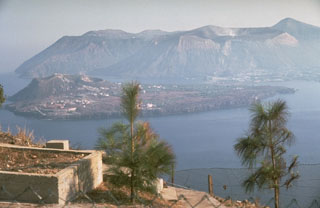Report on Vulcano (Italy) — November 1997
Bulletin of the Global Volcanism Network, vol. 22, no. 11 (November 1997)
Managing Editor: Richard Wunderman.
Vulcano (Italy) Trends in fumarolic gas composition during 1996-97
Please cite this report as:
Global Volcanism Program, 1997. Report on Vulcano (Italy) (Wunderman, R., ed.). Bulletin of the Global Volcanism Network, 22:11. Smithsonian Institution. https://doi.org/10.5479/si.GVP.BGVN199711-211050
Vulcano
Italy
38.404°N, 14.962°E; summit elev. 500 m
All times are local (unless otherwise noted)
Periodic observations of the chemical composition of fumarolic gases have been made at Vulcano since 1977. Several fumaroles with different temperatures but similar chemical compositions were observed. Differing trends in fumarolic gas composition at different locations on Vulcano have been observed during 1996-97.
Table 5 shows the trend in chemical composition of gases emitted by fumaroles on the rim and inside the crater during 1996-97. For fumaroles on the rim, percentages of typical magmatic species such as SO2, H2, and CO increased during 1996-97; percentages decreased for fumaroles inside the crater. Scientists estimated that the magmatic system was opening on the rim and closing inside the crater. This evolution pattern revealed that the stability of the system was affected by deformation of the Fossa cone produced by increased vapor pressures at depth.
Table 5. Fumarolic gas composition (percentages) on the rim (A) and inside the crater (B) of Vulcano, 1996-97. Courtesy of M. Martini.
| Component | A (rim) 1996 | A (rim) 1997 | B (crater) 1996 | B (crater) 1997 |
| Temperature | 348°C | 328°C | 399°C | 426°C |
| H2O (vol.) | 84.41 | 88.86 | 81.50 | 85.38 |
| CO2 (dry) | 93.90 | 92.37 | 97.40 | 97.13 |
| H2S | 2.66 | 3.10 | 0.41 | 0.40 |
| SO2 | 1.46 | 2.11 | 1.11 | 0.99 |
| HCl | 0.97 | 1.26 | 0.54 | 0.78 |
| HF | 0.52 | 0.46 | 0.077 | 0.029 |
| B | 0.017 | 0.023 | 0.014 | 0.017 |
| NH4 | 0.010 | 0.010 | 0.006 | 0.017 |
| H2 | 0.041 | 0.121 | 0.081 | 0.048 |
| N2 | 0.525 | 0.547 | 0.580 | 0.513 |
| CO | 0.00047 | 0.00072 | 0.0038 | 0.0024 |
Correction: Boris Behncke (Istituto di Geologia e Geofisica at Università di Catania) noted that during a visit in late April 1997 (BGVN 22:07) steam emissions from the Fossa Grande crater appeared slightly more voluminous than during visits in 1995 and 1996. This statement may have created a false impression of renewed increase in fumarolic activity when it was actually due to the relative humidity of the air. Fieldwork by other scientists during spring 1997 revealed low fumarole temperatures and less abundant emissions. This was confirmed by Behncke during June-July and 10-12 October when fumarolic emissions were the lowest since 1989.
Geological Summary. The word volcano is derived from Vulcano stratovolcano in Italy's Aeolian Islands. Vulcano was constructed during six stages over the past 136,000 years. Two overlapping calderas, the 2.5-km-wide Caldera del Piano on the SE and the 4-km-wide Caldera della Fossa on the NW, were formed at about 100,000 and 24,000-15,000 years ago, respectively, and volcanism has migrated north over time. La Fossa cone, active throughout the Holocene and the location of most historical eruptions, occupies the 3-km-wide Caldera della Fossa at the NW end of the elongated 3 x 7 km island. The Vulcanello lava platform is a low, roughly circular peninsula on the northern tip of Vulcano that was formed as an island beginning more than 2,000 years ago and was connected to the main island in about 1550 CE. Vulcanello is capped by three pyroclastic cones and was active intermittently until the 16th century. Explosive activity took place at the Fossa cone from 1898 to 1900.
Information Contacts: Marino Martini, Dipartimento di Scienze della Terra, Università di Firenze, Via La Pira 4, 50125, Firenze, Italy; Boris Behncke, Istituto di Geologia e Geofisica, Universitá di Catania, Corso Italia 55, 95129 Catania, Italy.

